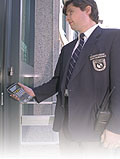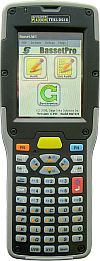Factors which affect read range for RFID
Read range for an RFID tag is affected by many factors, including:
- Passive, BAP, NFC or Active
- RFID frequency - LF, HF or UHF
- Surrounding materials
- Type of tag
- Type of reader
- Orientation
- Time to read
- Number of tags being read
- Density of tags
Given all of the above, the only general comment that we can make is that read range can be anywhere from half an inch to a hundred meters. For more information, please read on...
We address each of these issues in the following sections. Note that we have given general information assuming a typical working environment. The numbers we quote below are conservative, and reflect the different factors that affect read range. In all cases the numbers could be improved considerably if each of the factors above was optimised. So please take the numbers in the way they are intended, as a general guideline.
Passive, BAP, NFC or Active RFID?
Passive RFID is the most common. Power to the tags is provided by the reader, and the tag has no power source. Advantages include low cost, indefinite life, small size.
BAP tags (Battery Assisted Passive Tags)have an internal battery. They are more tolerant of surrounding materials, but they are more expensive, slightly larger, and have a finite life, typically two years.
NFC, for near field communication is essentially using passive RFID Tag technology to communicate in both directions. Low range is essentially a benefit in this case, as there is less chance for confusion as to which tag is communicating with which reader.
Active RFID gives greater range. Roles are reversed in this technology. The tag is powered, and emits a signal on a pre-determined schedule, which might typically be one beacon per second. The readers are receivers, typically static, powered and connected to a network. Read range is typically one hundred metres.
RFID Frequency
A little (recent) history here. The first RFID in common use was LF - Low Frequency. Used for animal tracking, it offered a low read range, typically an inch or two, which was, in this application, sometimes beneficial, as the person using the system had a lot of confidence in knowing which tag was being read. Disadvantages of LF technology included the cost and size of the tag. The tags required many turns of fine wire to transfer energy from the reader to the tag, and this made them expensive to produce, and bulky in appearance.
The next generation of tags were HF. These operated at a higher frequency, and required less turns. Tags could now be printed using conventional printed circuit board techniques, but as a complete circuit was reqired, tags had to use double sided laminate, with a through connection to complete the circuit. Tags were less expensive and less bulky than LF. Range was extended to perhaps twelve inches or so. Typical uses included door entry mechanisms.
The next generation of tags were easier tp manufacture, which leads to lower manufacturing costs and potentially smaller tags, though in this case antennae size became critical. The laminate could now be one sided. But antennae size moved up to three or four inches for peak performance. Read range with fixed readers is commonly up to ten or twenty feet, but in some conditions can approach one hundred feet, though this may not be a ""real world" figure
Surrounding materials
All RFID tags are affected by the materials around them, but the degree to which they are affected depends on the type of tag. Straight passive tags are affected most. These tags have no on board power source, so they rely on energy that they harvest from the reader. If they are close to conductive material, the transfer of power from the reader is disrupted, and the communication with the RFID chip is lost. Conductive materials in this case include metal and water, particularly salty water. The human body contains lots of salty water, so a passive RFID chip help close to the body (or in a pocket or wallet) may be difficult to read.
BAP tags are batter assisted power tags. An internal battery provides power, and so they are less affected by adjacent materials (though not totally immune). We are conducting tests now with BAP tags, and seeing a higher read rate than with conventional passive tags.
Active tags are even less sensitive to surrounding materials, but still not immune. One of our systems uses active RFID tags to track test equipment in a joint development and manufacturing facility. Most equipment is tracked accurately, but occasionally an item is placed "tag side down" on a metal shelf, and becomes invisible to the readers.
Tag Type
For all frequencies of tag there are different physical configurations. These usually make a trade off between size and sensitivity, particularly for UHF tags. We use small "button" tags for some laundry type applications. These have a read range of a few inches. The standard squiggle type tags are about four inches long and offer a much better read range, two or three feet. Encapsulated tags, such as the long blue tags from intermec are more reliable still for longer reads. And some tags have even longer antennae, specifically designed for use in car windscreens. We have read these reliably at a range of sixteen feet with a handheld reader.
Type of reader
Tags can be read with mobile or fixed readers. For UHF tags, power is provided by the reader, and the trade off between range, battery life and antenna size for a mobile reader means that read range is reduced. A typical working range for a mobile handheld reader is up to three feet, again, depending on tag configuration. A fixed mount reader has more power available, and a larger antenna. Read range in normal practical conditions can be up to twenty feet.
Orientation
The read range around a tag is not spherical. Tags are least sensitive "end on". The pattern of readability is also affected by the antenna of the reader, with circularly polarised antenna providing a shorter range but less reliance on orientation. A linear antenna can give a more impressive read range for a given tag, but turn the reader through ninety degrees, and the tag becomes invisible.
Time to read
The longer the read time, the better prospect for a read at the extremes of range. This is especially a challenge for portals, that try to read many tags on a skid that passes quickly through the portal. A particularly elegant solution is to place the reader on the fork lift truck, so that it has more time to read.
Number of tags being read
Not usually a serious problem unless the tag count is very high, but it can have an effect.
Density of Tags
This can particularly be a problem if small, thin items are to be tracked. Tracking physical file folders is a common application of RFID. This can work well on a pile of folders in use, where the contents spread the tags. But a pile of empty folders, which result in tags being placed back to back, can make the tags at the bottom of the pile difficult to read, as they are in the "shadow" of the tags above them.
Conclusion
The above might suggest that RFID is unreliable, or perhaps to complicated for practical use. To the contrary, it is a powerful technology for the right application. The above is intended to give some idea of the various factors that can affect the read rate, and which should at least be considered for any given application.
SageData is based in Ottawa, Ontario, Canada.
For further information, please contact us...
Send email to "info@sagedata.com"
Contact us by phone...
within Ottawa, dial (613) 225-4404
outside Ottawa, dial (888) 838-1067
© SageData . Ottawa . Ontario . Canada











